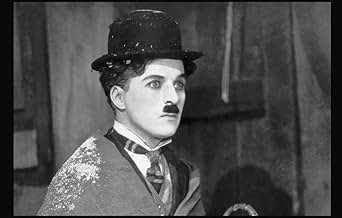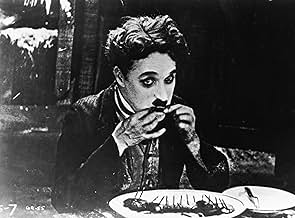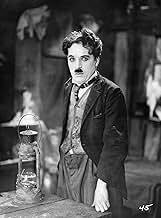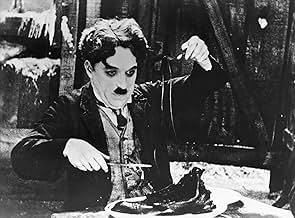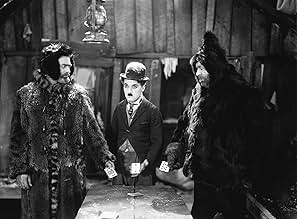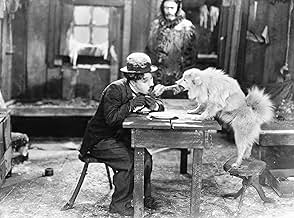Un buscador de oro se va en busca de fortuna al Klondike, y encuentra oro y mucho más.Un buscador de oro se va en busca de fortuna al Klondike, y encuentra oro y mucho más.Un buscador de oro se va en busca de fortuna al Klondike, y encuentra oro y mucho más.
- Dirección
- Guionista
- Elenco
- Nominado a 2 premios Óscar
- 7 premios ganados y 3 nominaciones en total
Jack Adams
- Man in Dance Hall
- (sin créditos)
Frank Aderias
- Eskimo Child
- (sin créditos)
Leona Aderias
- Eskimo Child
- (sin créditos)
Lillian Adrian
- Woman in Dance Hall
- (sin créditos)
Sam Allen
- Man in Dance Hall
- (sin créditos)
Claude Anderson
- Man in Dance Hall
- (sin créditos)
Harry Arras
- Man in Dance Hall
- (sin créditos)
Albert Austin
- Prospector
- (sin créditos)
F.J. Beauregard
- Man in Dance Hall
- (sin créditos)
Marta Belfort
- Woman in Dance Hall
- (sin créditos)
William Bell
- Man in Dance Hall
- (sin créditos)
Francis Bernhardt
- Man in Dance Hall
- (sin créditos)
- Dirección
- Guionista
- Todo el elenco y el equipo
- Producción, taquilla y más en IMDbPro
Resumen
Reviewers say 'The Gold Rush' is acclaimed for its comedy, visual storytelling, and iconic scenes. Charlie Chaplin's Little Tramp is lauded for humor and emotional depth. The film blends slapstick with themes of loneliness and resilience, resonating deeply. Its historical significance in silent cinema and influence on filmmakers are noted. The 1942 re-release with narration and music is appreciated, though some favor the original. It remains a timeless masterpiece.
Opiniones destacadas
One of the great Chaplin movies is 'The Gold Rush' and although it is not his best it contains one of the best known Chaplin-sequences. The sequence with the dancing rolls is one of the best I have seen in any Chaplin, whether it is a feature film or a two-reeler. For me this alone makes 'The Gold Rush' worth watching.
There are other great moments in this story where Chaplin is the Lone Prospector who falls in love with a girl named Georgia (Georgia Hale). When Chaplin has to find some gold (the movie isn't name 'The Gold Rush' for nothing) together with Hank (Henry Bergman) they stay in a cottage in the mountains. The sequence with this cottage after a blizzard is another that belongs to the greatest sequences in a Chaplin movie.
Of course we know from the start how things will end with the girl and the gold but the way that leads to that point is a nice one. Personally I think it is not great all the time, some sequences make it great, and sometimes even a little too simple. Because of the sequences described above (and some others) and because of the artist that Chaplin is this still belongs to the better silent movies I have seen.
There are other great moments in this story where Chaplin is the Lone Prospector who falls in love with a girl named Georgia (Georgia Hale). When Chaplin has to find some gold (the movie isn't name 'The Gold Rush' for nothing) together with Hank (Henry Bergman) they stay in a cottage in the mountains. The sequence with this cottage after a blizzard is another that belongs to the greatest sequences in a Chaplin movie.
Of course we know from the start how things will end with the girl and the gold but the way that leads to that point is a nice one. Personally I think it is not great all the time, some sequences make it great, and sometimes even a little too simple. Because of the sequences described above (and some others) and because of the artist that Chaplin is this still belongs to the better silent movies I have seen.
This silent classic has many strong points - it has a lot of humor, interesting characters, a good story and good settings. It's the kind of film that shows how much a master film-maker can communicate in a silent movie. It overdoes the sentimentality on occasion, but other than that it's a fine film.
Chaplin himself plays the 'Lone Prospector', and he is joined by several other interesting characters in a frozen north setting that sets up some good adventures and drama. There are some memorable scenes in the prospectors' rickety cabins, plus some other good material.
The version of this that is the easiest to find is the one that Chaplin re-edited in the 1940's, adding his own narration and deleting the title cards, which gives it a slightly different feel. (These revisions probably make it a bit easier to follow for those who aren't used to silent films.) You can tell from Chaplin's narration how fond he must have been of "The Gold Rush", and he had a lot of good reasons to be pleased with it. There are a couple of his later films that might be even better and more timeless, but this one contains everything that defined Chaplin and his art.
Chaplin himself plays the 'Lone Prospector', and he is joined by several other interesting characters in a frozen north setting that sets up some good adventures and drama. There are some memorable scenes in the prospectors' rickety cabins, plus some other good material.
The version of this that is the easiest to find is the one that Chaplin re-edited in the 1940's, adding his own narration and deleting the title cards, which gives it a slightly different feel. (These revisions probably make it a bit easier to follow for those who aren't used to silent films.) You can tell from Chaplin's narration how fond he must have been of "The Gold Rush", and he had a lot of good reasons to be pleased with it. There are a couple of his later films that might be even better and more timeless, but this one contains everything that defined Chaplin and his art.
I've seen both version of this film--the original silent version from 1925 and the re-release by Chaplin in the 1940s. The difference is that the re-release was designed to appeal to a new audience that expected sound from their movies. To do this, title cards were removed--having Chaplin narrate the film. In addition, Chaplin-created music (for the most part--some were classical pieces), sound effects and singing were added to make the movie more palatable to the average viewer. I personally like BOTH versions and the one you watch is up to you if you get a copy of the Warner Brothers release on DVD--it has both plus excellent DVD extras. Otherwise, there have been a lot of public domain versions on video out there--many with terrible quality prints or music or both. The Warner version is the most pristine and beautiful silent print you can find. The version usually shown on Turner Classic movies is the 1942 re-release.
I use this film for my American history class when we do our unit on the history of film, though I might, in the future, use it for my Psychology classes as well (I teach both) because Chaplin's genius came from his obsessive-compulsive nature. The movie reportedly had 27 times more film exposed than you actually see in the film and the shoe eating segment was shot after more than 60 takes!!
The plot involves Charlie going to Alaska for the Gold Rush at the turn of the century. Along the way, he has a series of misadventures that have been thoroughly discussed in the other reviews here on IMDb. Suffice to say, the supporting acting was excellent and the story kept an excellent pace and had enough slapstick to make it fun to watch (something not true of all full-length slapstick comedies--sometimes, their pacing was negatively affected by the transition from shorts to full-length).
This is a gorgeous, well-executed piece of American art and a must for any real cinemaniac. The musical score (arranged by Chaplin), direction, acting and cinematography all are simply perfect--making this, in my opinion, the best full-length silent comedy ever made. This is saying a lot considering how much I love Harold Lloyd and Buster Keaton's films!
I use this film for my American history class when we do our unit on the history of film, though I might, in the future, use it for my Psychology classes as well (I teach both) because Chaplin's genius came from his obsessive-compulsive nature. The movie reportedly had 27 times more film exposed than you actually see in the film and the shoe eating segment was shot after more than 60 takes!!
The plot involves Charlie going to Alaska for the Gold Rush at the turn of the century. Along the way, he has a series of misadventures that have been thoroughly discussed in the other reviews here on IMDb. Suffice to say, the supporting acting was excellent and the story kept an excellent pace and had enough slapstick to make it fun to watch (something not true of all full-length slapstick comedies--sometimes, their pacing was negatively affected by the transition from shorts to full-length).
This is a gorgeous, well-executed piece of American art and a must for any real cinemaniac. The musical score (arranged by Chaplin), direction, acting and cinematography all are simply perfect--making this, in my opinion, the best full-length silent comedy ever made. This is saying a lot considering how much I love Harold Lloyd and Buster Keaton's films!
Charles Chaplin's "The Gold Rush" is arguably his finest film. He stars as a wimpy prospector who decides to go to the Klondike in the hopes of striking it rich. What he does not realize is that he may find love (in the form of Georgia Hale) instead of money. In the end that may be all right with him. "The Gold Rush" shows everything that made Charles Chaplin the great performer, writer and director he was. Quite possibly the finest cinematic icon of the 20th Century, Chaplin showed humanity, love and an undying want to entertain all audiences throughout his stellar cinematic career. The movie is exceptional in every way. Although I am not as well-versed with movies from the 1920s as I am with the decades following it, I would still probably call "The Gold Rush" the finest film of that 10-year period. Oh how the cinema misses Charles Chaplin today. 5 stars out of 5.
... in which Chaplin tried to modernize The Gold Rush by taking out the title cards, adding narration which he himself did, changing the music, and deleting some scenes. It isn't bad since Chaplin himself redid it, but I just prefer the original.
It isn't as funny as The Kid, not as heartbreaking as City Lights, and it doesn't have the social commentary of Modern Times. Instead it has a little bit of everything plus lots of atmosphere AND it takes Chaplin's Little Tramp out of some anonymous urban environment and lands him in a very specific place and time - the Klondike gold rush of the late 1890s. I could feel the biting cold, the hunger, the loneliness. And in spite of this being set in the 1890s and seeming quite authentic to its setting, this film has a very modern feel to it, almost timeless.
Chaplin's "little fellow" is introduced as a lone prospector. We never see him doing any prospecting, but it is later mentioned that he is not very successful at it and gives it up. The first part of the film has the little fellow waiting out a blizzard in a cabin with a wanted criminal in addition to a fellow prospector. The second part has Chaplin's character traveling to a Klondike boom town, watching a cabin for a more successful prospector, and falling in love with a dance hall girl who thinks his crush is just a big joke, at least at first.
I don't think it was Chaplin's best silent film, but it does manage to do all aspects of the production very well and I can see why some people would judge it as his best. And if that was Chaplin in that chicken suit, all I can say is that he had the motions of a chicken down pat. To know what I'm talking about, watch and find out.
It isn't as funny as The Kid, not as heartbreaking as City Lights, and it doesn't have the social commentary of Modern Times. Instead it has a little bit of everything plus lots of atmosphere AND it takes Chaplin's Little Tramp out of some anonymous urban environment and lands him in a very specific place and time - the Klondike gold rush of the late 1890s. I could feel the biting cold, the hunger, the loneliness. And in spite of this being set in the 1890s and seeming quite authentic to its setting, this film has a very modern feel to it, almost timeless.
Chaplin's "little fellow" is introduced as a lone prospector. We never see him doing any prospecting, but it is later mentioned that he is not very successful at it and gives it up. The first part of the film has the little fellow waiting out a blizzard in a cabin with a wanted criminal in addition to a fellow prospector. The second part has Chaplin's character traveling to a Klondike boom town, watching a cabin for a more successful prospector, and falling in love with a dance hall girl who thinks his crush is just a big joke, at least at first.
I don't think it was Chaplin's best silent film, but it does manage to do all aspects of the production very well and I can see why some people would judge it as his best. And if that was Chaplin in that chicken suit, all I can say is that he had the motions of a chicken down pat. To know what I'm talking about, watch and find out.
¿Sabías que…?
- TriviaSir Charles Chaplin stated that this was the film by which he most wanted to be remembered.
- ErroresWhen Big Jim is delirious and thinks The Lone Prospector is a chicken, The Lone Prospector removes a knife from the table and hides it in the bed. In one of the next shots, the knife is back on the table. Then in the next shot, it is gone again.
- Versiones alternativasThere is a 1942 re-issue version, prepared by Charles Chaplin himself, which uses his own narration, music score, and editing (running time: 72 minutes). This version is the only one which has its copyright owned by the Chaplin Film company. Many scenes of the 1942 version derived from an alternate camera that was shooting simultaneously. This explains some of the very slight differences in camera angle, although Chaplin also deleted some footage in order to tighten the pacing (such as Big Jim and the Tramp's near-encounter in the Gold Rush town and the shot of a woman comforting another woman during the singing of "Auld Lang Syne".
- ConexionesEdited into Werner Herzog Eats his Shoe (1980)
Selecciones populares
Inicia sesión para calificar y agrega a la lista de videos para obtener recomendaciones personalizadas
- How long is The Gold Rush?Con tecnología de Alexa
- Is this movie based on a novel?
Detalles
- Fecha de lanzamiento
- País de origen
- Sitios oficiales
- Idiomas
- También se conoce como
- The Gold Rush
- Locaciones de filmación
- Productora
- Ver más créditos de la compañía en IMDbPro
Taquilla
- Presupuesto
- USD 923,000 (estimado)
- Total a nivel mundial
- USD 68,467
- Tiempo de ejecución1 hora 35 minutos
- Color
- Mezcla de sonido
- Silent(original release)
- Relación de aspecto
- 1.33 : 1
Contribuir a esta página
Sugiere una edición o agrega el contenido que falta

Principales brechas de datos
What is the Japanese language plot outline for La quimera del oro (1925)?
Responda

